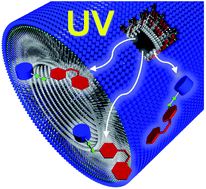Retracted Article: Photo-responsive hole formation in the monolayer membrane wall of a supramolecular nanotube for quick recovery of encapsulated protein†
Abstract
Nanotubes with a single monolayer membrane wall comprised of a synthetic glycolipid and one of two synthetic azobenzene derivatives were assembled. X-ray diffraction, infrared, UV-visible, and circular dichroism spectroscopy clarified the embedding style of the azobenzene derivatives in the membrane wall, revealing that, depending on their different intermolecular hydrogen bond strengths, one azobenzene derivative was individually dispersed whereas the other formed a J-type aggregate. The non-aggregated derivative was insensitive to UV irradiation due to tight fixation by the surrounding glycolipid. In contrast, the aggregated derivative was sensitive to UV irradiation, which induced trans-to-cis isomerization of the derivative and disassembly of the J-type aggregate. Subsequent dissociation of the derivative into the bulk solution resulted in the formation of many nanometer-scale holes in the membrane wall. Although a model protein encapsulated within the nanotubes was slowly released over time from the two open ends of the nanotubes without UV irradiation, exposure to UV irradiation resulted in faster, preferential release of the protein through the holes in the membrane wall. The present findings are expected to facilitate the development not only of efficient means of recovering guest compounds stored within nanotubes but also the development of novel stimuli-responsive capsules in biological and medical fields.



 Please wait while we load your content...
Please wait while we load your content...